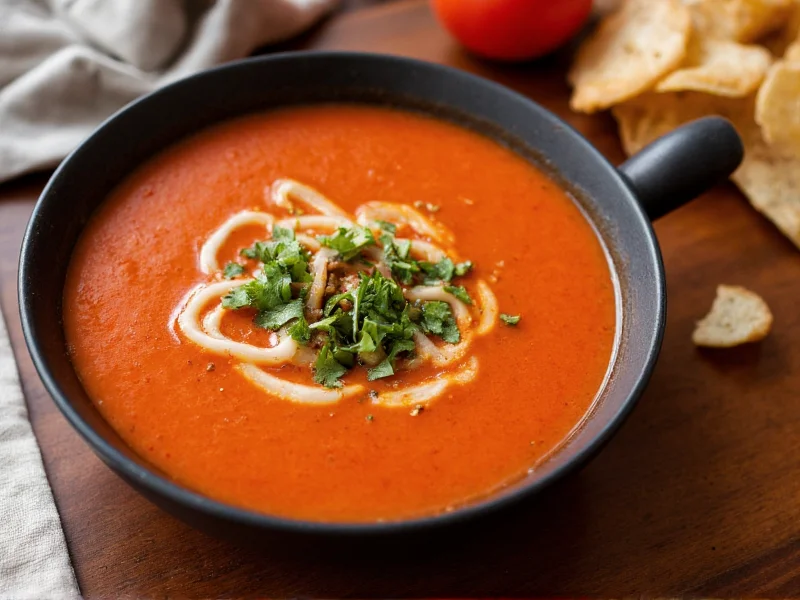When home cooks search for how to make Rao's style tomato soup, they're typically looking to recreate the beloved flavor profile of the iconic New York restaurant's dishes using the commercially available sauce products. Understanding this distinction is crucial for anyone exploring Rao's tomato sauce as soup base options.
What Rao's Tomato Soup Really Refers To
The confusion around Rao's tomato soup recipe stems from the restaurant's legendary status in Italian-American cuisine. Rao's Restaurant in New York, established in 1896, became famous for its slow-simmered tomato sauces served tableside. When Rao's Homemade launched bottled sauce products in 1996, home cooks began using these sauces as convenient bases for tomato soup.
Unlike dedicated soup products, Rao's offers several tomato-based sauces that home chefs adapt:
- Rao's Homemade Marinara Sauce
- Rao's Homemade Tomato Basil Sauce
- Rao's Homemade Arrabbiata Sauce
- Rao's Homemade Vodka Sauce
Ingredients and Flavor Profile Analysis
The appeal of using Rao's sauce for soup lies in its ingredient simplicity. Most varieties contain just tomatoes, olive oil, garlic, and basil—without added sugar or preservatives that appear in many competing brands. This clean ingredient list makes adapting Rao's sauce into tomato soup straightforward for home preparation.
When evaluating how Rao's tomato sauce compares to soup products, note these key characteristics:
- Thicker consistency than most canned soups
- Higher tomato concentration
- No added thickeners or starches
- Rich umami flavor from slow-cooked tomatoes
- Noticeable olive oil content on the surface
Comparing Sauce-to-Soup Adaptation Options
| Adaptation Method | Liquid Ratio | Additional Ingredients | Resulting Flavor Profile |
|---|---|---|---|
| Basic broth dilution | 1:1 sauce to broth | None | Pure tomato essence, restaurant-style |
| Cream variation | 2:1 sauce to cream | Pinch of red pepper flakes | Rich, velvety texture with subtle heat |
| Roasted vegetable | 3:1 sauce to vegetable stock | Roasted garlic, carrots, celery | Complex depth, natural sweetness |
| Quick pantry version | 4:1 sauce to water | Dried oregano, Parmesan rind | Lighter consistency, herb-forward |
Practical Applications in Home Cooking
Professional chefs and home cooks alike have developed reliable methods for transforming Rao's sauce into satisfying tomato soup. The most authentic approach involves thinning the sauce with low-sodium vegetable or chicken broth while maintaining the sauce's characteristic richness.
For those exploring healthy adaptations of Rao's tomato soup, consider these techniques:
- Add roasted red peppers for natural sweetness without sugar
- Stir in a Parmesan cheese rind while simmering for umami depth
- Blend with roasted butternut squash for creaminess without dairy
- Incorporate fresh basil at the end for vibrant flavor
Availability and Product Considerations
Rao's sauce products appear in most major grocery chains across the United States, typically in the pasta sauce aisle. When selecting sauce for making restaurant-style tomato soup at home, check the production date as freshness significantly impacts flavor. The glass jars maintain quality longer than the plastic containers.
Consumers researching is Rao's sauce worth it for soup making should note the premium pricing reflects the olive oil content and absence of preservatives. A single 24-ounce jar typically makes two generous servings of soup when properly diluted.
Consumer Experience and Practical Tips
Home cooks consistently report that Rao's sauce makes superior tomato soup compared to dedicated soup products, primarily due to ingredient quality. The most common feedback centers on:
- Superior tomato flavor without metallic aftertaste
- Versatility across multiple soup variations
- Noticeable absence of added sugar
- Rich mouthfeel from high-quality olive oil
For best results when preparing easy tomato soup using Rao's sauce, remember to:
- Always heat gently—never boil—to preserve flavor
- Add liquid gradually to achieve desired consistency
- Finish with fresh herbs for brightness
- Allow flavors to meld for 10-15 minutes before serving
Frequently Asked Questions
Does Rao's make an actual tomato soup product?
No, Rao's does not manufacture a dedicated tomato soup product. What many refer to as 'Rao's tomato soup' is actually their marinara or tomato basil sauce used as a base for homemade soup. The restaurant's famous tomato preparation method inspired home cooks to adapt the bottled sauces into soup.
How do you turn Rao's sauce into tomato soup?
To transform Rao's sauce into soup, combine one part sauce with one part low-sodium broth or water. Heat gently without boiling, then customize with additions like cream for richness, roasted vegetables for depth, or fresh herbs for brightness. Simmer for 10-15 minutes to allow flavors to meld.
Why do people prefer Rao's sauce for making tomato soup?
Home cooks prefer Rao's sauce for soup due to its simple ingredient list (tomatoes, olive oil, garlic, basil—no added sugar), rich flavor profile, and restaurant-quality consistency. The absence of preservatives and thickeners allows for more authentic, customizable soup preparation compared to dedicated soup products.
Is Rao's sauce worth the higher price for soup making?
Many home chefs find Rao's sauce worth the premium price for soup making due to its superior ingredient quality and flavor concentration. A single jar typically makes two generous soup servings, and the absence of added sugar or preservatives provides greater control over the final product's nutritional profile and taste.
Can you make vegan tomato soup using Rao's sauce?
Yes, all Rao's tomato-based sauces are naturally vegan. To make vegan tomato soup, simply thin the sauce with vegetable broth instead of chicken broth and omit any dairy additions. For creaminess, blend with roasted cauliflower or white beans instead of using cream.











 浙公网安备
33010002000092号
浙公网安备
33010002000092号 浙B2-20120091-4
浙B2-20120091-4